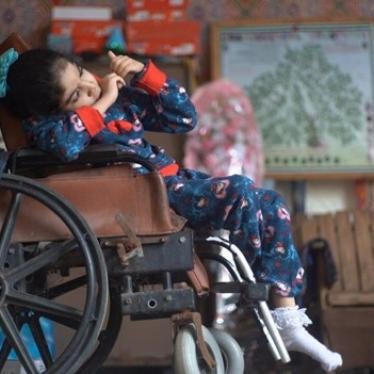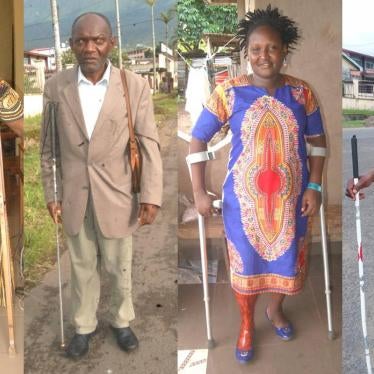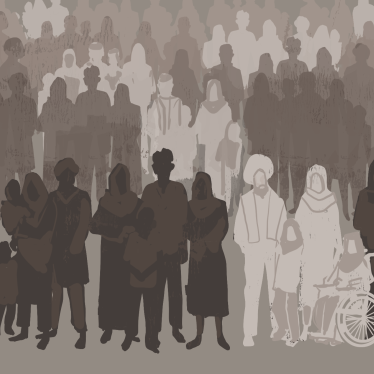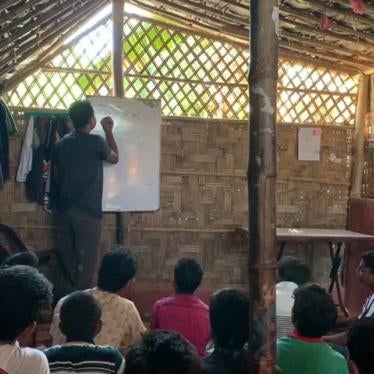Human Rights Watch welcomes the opportunity to provide input to the UN Special Rapporteur on the Rights of Persons with Disabilities for his thematic report to the 76th session of the United Nations General Assembly regarding the rights of persons with disabilities in armed conflict.
This submission is based on Human Rights Watch’s research in Afghanistan, Cameroon, the Central African Republic, Israel/Palestine, Jordan, Lebanon, South Sudan, and Syria.
We focus on six issues in particular:
- At higher risk during fighting
- Availability of assistive devices
- Access to basic services
- Education for children with disabilities
- Abuse and stigma
- Mental health impact
1. Please provide information on whether and how your organization engages on the protection of persons with disabilities under international humanitarian law.
Human Rights Watch is an independent, international human rights organization that works to improve human rights, including the rights of persons with disabilities, in more than 100 countries around the world. Our work is guided by international human rights and humanitarian law and respect for the dignity of each person.
Since 2015, Human Rights Watch has investigated the impact of armed conflicts and humanitarian emergencies on persons with disabilities. We have published our findings in over 22 publications on Cameroon, the Central African Republic, Israel/Palestine, Jordan, Lebanon, South Sudan, and Syria.
5. Please provide information on how civil society, specifically OPDs, are involved in the process to identify and address discrimination and marginalization of persons with disabilities in situations of armed conflict, conflict prevention, humanitarian action, and peacebuilding operations.
Human Rights Watch consistently consults with persons with disabilities and their representative organizations and engages with them in research and advocacy at local, national, regional, and international forums.
For example, for our research and advocacy on Syria, we consulted local activists with disabilities including Nujeen Mustafa during the design and throughout the implementation of our project on protection of persons with disabilities. Together with Ms. Mustafa, we identified and interviewed people and organizations in Syria who could provide up-to-date information on the situation of people with disabilities in Syria, ensuring that their unique human rights stories are told before the world. We also supported Ms. Mustafa to prepare her address to the April 2019 UN Security Council briefing on the humanitarian situation in Syria.[1]
Human rights concerns and people with disabilities in armed conflict:
At higher risk during fighting
Situations of armed conflict often force people to flee areas when violence erupts. Persons with disabilities can be at higher risk of harm during fighting. Human Rights Watch research in Cameroon, Central African Republic, Israel/Palestine, Syria, and South Sudan found that persons with disabilities faced several difficulties fleeing armed attacks on their communities. Persons with physical disabilities may struggle to flee and seek shelter without assistance and access to assistive devices. For example, during Israel’s military offensive in Gaza in 2014, a 26-year-old woman with a physical disability was unable to flee with the rest of her family when a missile struck her house.[2] She was wounded in the leg and her mobility scooter was destroyed. She managed to flee to safety only when a relative returned to help her.
People who are blind or have low vision may require support from others to flee. Persons with hearing, developmental, or intellectual disabilities often cannot hear, know about, or understand what occurs during attacks. For example, a 43-year-old man with hearing and intellectual disabilities who lived in the North-West region of Cameroon was killed by Rapid Intervention Battalion soldiers because he did not answer their questions. “He was shot in the head and the chest,” a witness said.[3] Persons with disabilities can also be significantly impacted by the degradation of support systems that existed prior to the conflict.[4]
Human Rights Watch research in 2019 in Cameroon also found that older persons with disabilities often would stay behind in villages, including during attacks, due to the risks of fleeing in inaccessible terrain and potentially complicating their family’s or neighbors’ escape attempts. The daughter of a 75-year-old man said that she had to abandon her father, who is blind and has a mental health condition and a physical disability, at home in the deserted village, with little access to food and water, because she could have otherwise been killed by armed forces if she did not escape quickly enough.[5]
Lack of access to assistive devices
Human Rights Watch has documented that a key challenge for escaping hostilities is the absence of assistive devices such as wheelchairs, prostheses, crutches, or hearing aids. Research in Cameroon in 2019 found that security forces destroyed and looted hundreds of homes across the Anglophone regions.[6] Persons with disabilities often lost everything, including their accessible homes, assistive devices, and their livelihoods.
One single mother with a physical disability who struggled to flee the South-West region in Cameroon did not have access to an assistive device. She used a small tree branch as a walking cane to support herself.[7] A young man with an artificial leg that broke when he fled into the forest after clashes was forced to leave the leg in the forest and has since walked on crutches.[8]
Israel’s 13-year closure of the Gaza Strip along with neglect by Hamas authorities significantly encumber the lived experiences of tens of thousands of Palestinians with disabilities. Electricity shortages often leave Gaza residents without electricity for 9 to 14 hours per day. These restrictions affect the entire population but have a disproportionate impact on persons with disabilities. They may not only be confined to their homes but may also be prevented from fleeing during fighting.
Some Gaza residents reported in 2019 not being able to charge their scooters, trapping them in their homes. Even if their wheelchairs or other mobility devices were working, they often cannot leave their homes or access other buildings due to a lack of ramps and elevators.[9]
Others reported obstacles to access to assistive devices, such as wheelchairs and hearing aids, largely due to Israeli import restrictions, shortfalls in local authorities’ and aid groups’ provision of necessary devices, and a lack of expertise in Gaza to repair damaged assistive devices.
Access to basic services
Persons with disabilities displaced by armed conflict can face serious obstacles to meeting basic needs such as food, sanitation, and health care due to service provision by states, civil society and relief organizations, religious institutions, and local charities that is inaccessible.
In 2019 in Cameroon, Human Rights Watch interviewed displaced persons with disabilities, of whom only 9 of the 45 interviewees received humanitarian assistance.[10] In all but one case, aid was distributed by local charities in urban centers and not in rural settings. In urban settings, people with disabilities also faced overcrowding and difficulty accessing water and sanitation facilities. One UN employee based in the South-West region in Cameroon told Human Rights Watch, “There are large swathes of the Anglophone regions where the crisis has hit the local population hard, but where aid organizations are yet to deliver anything.”[11]
In 2015 and 2017 Human Rights Watch research in the Central African Republic in Bambari and Kaga-Bandoro displacement camps found that residents with disabilities, particularly those without family members, struggled to get food due to the often chaotic and disorganized nature of food distributions. A camp resident with a disability said, “Everyone is mixed and people start to fight with each other after a few minutes, so we people with disabilities must watch from the sidelines and just try to get what is left over.”[12]
In addition, many camp residents with disabilities were forced to crawl on the ground to access water and sanitation services, such as latrines and showers, exposing them to health risks due to a lack of ramps, bars, and other forms of support.[13]
Disability intersects with other forms of marginalization such as gender, making it even harder for some people with disabilities to access support and services. In Afghanistan, Human Rights Watch documented that Afghan women and girls with disabilities face huge difficulties accessing education, health care, and employment and are at a heightened risk of sexual harassment when they seek financial assistance or employment from government institutions.[14]
Education for children with disabilities
Children with disabilities affected by armed conflict often face serious obstacles to access education, support services, and assistive devices.
In Afghanistan, an estimated 80 percent of girls with disabilities are not enrolled in schools - resistance from schools to accommodating children with disabilities is a major factor in children with disabilities not attending school.[15]
In Bangladesh, all Rohingya refugee children who fled from atrocities by the Myanmar military have been denied access to formal, quality education. Estimates of the number of Rohingya children with disabilities vary, but all available information indicates that, at the least, tens of thousands of children are affected and that the vast majority are completely excluded from any education whatsoever.[16]
Since the armed conflict in Syria began in 2011, hundreds of thousands of Syrian children residing as refugees in Jordan and Lebanon have faced obstacles in accessing formal education.
In Lebanon, only 42 percent of the 660,000 Syrian school-age children were enrolled in formal education during the 2018-2019 academic year.[17] Syrian children with disabilities, in particular, face obstacles in accessing education in Lebanon, as public schools discriminate against children with disabilities. Children with disabilities are often denied admission to schools because of their disability. And for those who manage to enroll, most schools do not take reasonable steps to provide them with a quality education or require the families of children with disabilities to pay hefty fees that are in effect discriminatory. Instead, many children with disabilities in Lebanon attend institutions that are not mandated to provide an education, or receive no education at all.[18]
Human Rights Watch research in Jordan in 2015 and 2016 found that tens of thousands of Syrian refugees, including children with disabilities, have been unable to obtain or update documents called “service cards,” which are issued to Syrians by Jordan’s Interior Ministry and have been required for Syrian children to enroll in public schools.[19] Syrian children in Jordan, as in Lebanon, may not be enrolled at the nearest school if it is overcrowded. And they may not enroll in distant schools because their parents live in poverty and may be unable to afford transportation, which is not provided by schools.
Between January and April 2015, Human Rights Watch documented that very few children with disabilities were enrolled in schools in camps for internally displaced persons in the Central African Republic.[20] For example, in the M’Poko camp, out of the 3,797 children enrolled, only 14 had disabilities. Low enrollment of children with disabilities can be linked to inaccessibility. The school in the M’Poko camp is wheelchair-accessible, but the route to the school is not.
Stigma and Abuse
Persons with disabilities and older persons often face stigma and abuse from their family and their communities.
Hamamatou, then a 14-year-old girl with polio from a village in the Central African Republic, told Human Rights Watch that when her community was attacked, her brother carried her on his back until he got too tired to continue. When anti-balaka fighters found Hamamatou two weeks later, they said, “We have found an animal. Let’s finish it off.” Another anti-balaka fighter intervened to save her life.[21]
In 2017, aid workers in South Sudan told Human Rights Watch, “We’ve encountered cases of relatives physically abusing people with disabilities, beating them, or forcibly taking their food or other possessions from them.”[22]
Conflicts exacerbate stigma, resulting in extreme practices including threats, shackling and physical and verbal abuse in the community (including hurtful and offensive comments).
For example, in the Gaza Strip, Human Rights Watch documented the case of “Hala,” an 18-year-old woman who has been chained since she was a child as she started displaying signs of a mental health condition.[23] Hala’s mother said that as they did not have access to quality mental health care and psychosocial support for their daughter, they decided to chain Hala’s hands and one of her feet during the day to prevent her from breaking household objects or fleeing the house, only unchaining her at night when she sleeps with her mother inside a locked room.
Human Rights Watch has documented the shackling of hundreds of thousands of people with psychosocial disabilities in over 60 countries around the world, including in countries facing armed conflict.[24]
Current Human Rights Watch research on the situation of children with disabilities in Syria uncovered the practice of shackling. Two humanitarian workers in Syria said that the chaining of children with disabilities existed prior to the Syrian civil war, but has increased since the conflict started.[25] They attributed this to a lack of access to services and support. According to Syria Civil Defense, a nongovernmental organization, this abuse is more frequent among children who have psychosocial disabilities and have also lost their parents in the war, and only have extended family to care for them.[26]
Mental health impact
In 2020, Human Rights Watch documented that many people with disabilities in Gaza experienced psychological distress as a result of Israel’s closure of Gaza and protracted hostilities, as well as the other barriers they face. In particular, many pointed to traumatic experiences during hostilities and their difficulty or inability to flee danger in the event of future attacks.
Five people with disabilities described severe difficulties fleeing buildings that came under attack during Israeli offensives between 2009-2014, and their need for help to reach safety.[27] Israeli forces sometimes provided warnings only minutes before carrying out airstrikes–not enough time for people with disabilities to flee.
The 26-year-old woman with a physical disability interviewed in 2019 said that she still hears the sound of explosions in her head from the 2014 war, gets frightened whenever she hears ambulances, and avoids “looking at the sky.”[28]
Ahmed Abu Salama, 27, said that, during the 2014 hostilities, an Israeli drone struck the mosque where he was praying.[29] Everyone fled but he froze, unsure if he could flee in his wheelchair. He waited a few minutes until some people returned and carried him out. In the 2008-2009 hostilities, he said, a bullet struck the wall above his head in the hospital room where he lay, and he managed to escape only with another person’s assistance. Abu Salama said that the incidents stayed with him and to this day he is startled every time he hears a loud sound.
Current Human Rights Watch research in Syria shows that the conflict and lack of access to services has had a devastating impact on the mental health of children with disabilities there.
Thara, 18, who lost her leg in a barrel bomb attack when she was 13, said she fears future abuse and airstrikes. She said, “With every airstrike I feel I might lose my life or another limb. I am still seeing my people being killed, injured and disabled because of this conflict. Psychologically I don’t feel well but we will support each other hoping that this conflict will end one day.”[30]
Dib Al Hadid, the mother of seven children, including a 13-year-old boy who has intellectual and physical disabilities, said constant forced displacement and lack of access to support and education has affected her children’s mental health.[31] She said, “Most of my kids have a lot of difficulties psychologically. Especially when it comes to any loud sound; you can see the fear in their eyes. They have no hopes for the future.”[32] Al Hadid explained that the war has had an especially profound impact on her 13-year-old: “This situation made him more withdrawn. He sits alone, doesn’t want to interact with any other kids.”
In Afghanistan, which has been devastated by 40 years of armed conflict, it is estimated that half the population experiences depression, anxiety, or post-traumatic stress, which can have a disastrous impact on people’s mental health and the well-being of their relatives and friends. Despite this, the government only spends about US$0.26 per capita on mental health. The World Health Organization says an appropriate mental health system in low-income countries such as Afghanistan would require an investment of $3 to $4 per capita. International donors have invested heavily in health services but focused their attention on physical, rather than mental health.[33]
We recommend that the Special Rapporteur:
- Affirm that persons with disabilities are at higher risk during fighting in armed conflicts and that States are obligated to take all necessary precautions to protect people with disabilities under their control;
- Urge all States and humanitarian aid organizations to follow the UN Inter-Agency Standing Committee’s (IASC) “Guidelines on the Inclusion of Persons with Disabilities in Humanitarian Action” to ensure that persons with disabilities are included in all phases of humanitarian action, from planning to coordination and monitoring;
- Urge States and humanitarian aid organizations to ensure that assistive technology is rapidly available, including by ensuring that funds are allocated in humanitarian planning for the acquisition and dissemination of assistive devices in armed conflict settings;
- Urge all States to support and accelerate measures to ensure all public buildings are accessible by building ramps and making toilets and other facilities accessible;
- Urge all States and humanitarian aid agencies to ensure access to basic services for persons with disabilities in internal displacement camps, including by providing priority or separate access to food and sanitation services for displaced persons with disabilities in the camps;
- Urge States and humanitarian aid agencies to develop targeted programs to provide crucial services such as rehabilitation, assistive devices, and accessible information;
- Request all States and humanitarian aid agencies to identify, register, and include in any data collection disaggregated information on persons with disabilities and their needs;
- Ask all States to ensure quality, inclusive education for all children, including children with disabilities. Identify high-need areas and schools in which to immediately develop inclusive education programs equipped to support children with disabilities, including by making necessary accommodations, creating accessibility, and allocating qualified trained teachers;
- Ask all States to ensure structural changes to existing schools or develop new schools that would remove barriers for children with disabilities who have been left out of education due to conflict and lack of access;
- Urge all States to raise awareness about the rights and dignity of persons with disabilities, including how disability intersects with other forms of marginalization based on factors like gender, nationality, age, race, ethnicity, caste, sexual orientation, and gender identity, and combat social stigma, discrimination, and harmful practices, to ensure that persons with disabilities can participate with others on an equal basis in their communities; and
- Affirm the mental health impact that armed conflicts have on people with disabilities and ask that all States and humanitarian aid organizations ensure all mental health and psychosocial services are accessible and inclusive of people with disabilities.
[1] Human Rights Watch, “UN: Landmark Security Council Disability Rights Briefing,” Human Rights Watch news release, April 24, 2019, https://www.hrw.org/news/2019/04/24/un-landmark-security-council-disability-rights-briefing.
[2] Human Rights Watch, “Gaza: Israeli Restrictions Harm People with Disabilities,” Human Rights Watch news release, December 3, 2020, https://www.hrw.org/news/2020/12/03/gaza-israeli-restrictions-harm-people-disabilities.
[3] Human Rights Watch, “Cameroon: People with Disabilities Caught in Crisis,” Human Rights Watch news release, April 5, 2019, https://www.hrw.org/news/2019/08/05/cameroon-people-disabilities-caught-crisis.
[4] Human Rights Watch, “Cameroon: Make Humanitarian Response More Inclusive,” Human Rights Watch news release, December 10, 2019, https://www.hrw.org/news/2019/12/10/cameroon-make-humanitarian-response-more-inclusive.
[5] Ibid.
[6] Human Rights Watch, “Cameroon: People with Disabilities Caught in Crisis.”
[7] Ibid.
[8] Ibid.
[9] Human Rights Watch, “Gaza: Israeli Restrictions Harm People with Disabilities,” Human Rights Watch news release, December 3, 2020, https://www.hrw.org/news/2020/12/03/gaza-israeli-restrictions-harm-people-disabilities.
[10] Human Rights Watch, “Cameroon: People with Disabilities Caught in Crisis,” Human Rights Watch news release, April 5, 2019, https://www.hrw.org/news/2019/08/05/cameroon-people-disabilities-caught-crisis.
[11] Ibid.
[12] Human Rights Watch, “Central African Republic: People with Disabilities at High Risk,” Human Rights Watch news release, June 21, 2017, https://www.hrw.org/news/2017/06/21/central-african-republic-people-disabilities-high-risk.
[13] Ibid.
[14] Human Rights Watch, Disability Is Not Weakness: Discrimination and Barriers Facing Women and Girls with Disabilities in Afghanistan (New York: Human Rights Watch, 2020), https://www.hrw.org/report/2020/04/28/disability-not-weakness/discrimination-and-barriers-facing-women-and-girls.
[15] Ibid.
[16] Human Rights Watch, Are We Not Human?: Denial of Education for Rohingya Refugee Children in Bangladesh (New York: Human Rights Watch, 2019), https://www.hrw.org/report/2019/12/03/are-we-not-human/denial-education-rohingya-refugee-children-bangladesh.
[17] Human Rights Watch, “Lebanon: Action Needed on Syrian Refugee Education Crisis,” Human Rights Watch news release, March 26, 2021, https://www.hrw.org/news/2021/03/26/lebanon-action-needed-syrian-refugee-education-crisis.
[18] Human Rights Watch, “Lebanon: Schools Discriminate Against Children with Disabilities,” Human Rights Watch news release, March 22, 2018, https://www.hrw.org/news/2018/03/22/lebanon-schools-discriminate-against-children-disabilities.
[19] Human Rights Watch, “Jordan: Positive Steps on Education for Syrian Children,” Human Rights Watch news release, August 22, 2016, https://www.hrw.org/news/2016/08/22/jordan-positive-steps-education-syrian-children.
[20]Human Rights Watch, “Central African Republic: People With Disabilities Left Behind,” Human Rights Watch news release, April 28, 2015, https://www.hrw.org/news/2015/04/28/central-african-republic-people-disabilities-left-behind.
[21] Human Rights Watch, “Central African Republic: People With Disabilities Left Behind,” Human Rights Watch news release, April 28, 2015, https://www.hrw.org/news/2015/04/28/central-african-republic-people-disabilities-left-behind.
[22] Human Rights Watch, “South Sudan: People with Disabilities, Older People Face Danger,” Human Rights Watch news release, May 31, 2017, https://www.hrw.org/news/2017/05/31/south-sudan-people-disabilities-older-people-face-danger.
[23] Human Rights Watch, “Gaza: Israeli Restrictions Harm People with Disabilities,” Human Rights Watch news release, December 3, 2020, https://www.hrw.org/news/2020/12/03/gaza-israeli-restrictions-harm-people-disabilities.
[24]Human Rights Watch, Living in Chains: Shackling of People with Psychosocial Disabilities Worldwide (New York: Human Rights Watch, 2020), https://www.hrw.org/report/2020/10/06/living-chains/shackling-people-psychosocial-disabilities-worldwide.
[25] Human Rights Watch phone interview with a Child Protection Specialist at Hurras Network, April 22, 2021; Human Rights Watch phone interview with a Protection Coordinator at Violet Syria, April 22, 2021.
[26] Human Rights Watch phone interview with representatives from Ayman Akkad and Mousa Zidane, Civil Defense Syria, May 25, 2021.
[27] Human Rights Watch, “Gaza: Israeli Restrictions Harm People with Disabilities,” Human Rights Watch news release, June 8, 2021, https://www.hrw.org/news/2020/12/03/gaza-israeli-restrictions-harm-people-disabilities.
[28] Ibid.
[29] Ibid.
[30] Human Rights Watch phone interview with Thara Jifrony, October 9, 2020.
[31] Human Rights Watch phone interview with Dib Al Hadid, October 7, 2020.
[32] Human Rights Watch phone interview with Dib Al Hadid, October 7, 2020.
[33] Human Rights Watch, “Afghanistan’s Silent Mental Health Crisis,” Human Rights Watch news release, October 7, 2019, https://www.hrw.org/news/2019/10/07/afghanistans-silent-mental-health-crisis.








